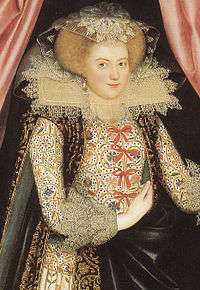Jacobean embroidery


Jacobean embroidery refers to embroidery styles that flourished in the reign of King James I of England in first quarter of the 17th century.
The term is usually used today to describe a form of crewel embroidery used for furnishing characterized by fanciful plant and animal shapes worked in a variety of stitches with two-ply wool yarn on linen. Popular motifs in Jacobean embroidery, especially curtains for bed hangings, are the Tree of Life and stylized forests, usually rendered as exotic plants arising from a landscape or terra firma with birds, stags, squirrels, and other familiar animals.[1][2]
Origins
Early Jacobean embroidery often featured scrolling floral patterns worked in colored silks on linen, a fashion that arose in the earlier Elizabethan era. Embroidered jackets were fashionable for both men and women in the period 1600-1620, and several of these jackets have survived.

Legacy
Jacobean embroidery was carried by British colonists to Colonial America, where it flourished. The Deerfield embroidery movement of the 1890s revived interest in colonial and Jacobean styles of embroidery.
Gallery


 Sketch of a leaf worked in indigo, brown, and light green[1]
Sketch of a leaf worked in indigo, brown, and light green[1] Portion of a 17th-century hanging "with a conventional representation
Portion of a 17th-century hanging "with a conventional representation Embroidered wool-work curtain of the 17th or 18th century[2]
Embroidered wool-work curtain of the 17th or 18th century[2]
See also
Notes
- 1 2 3 4 Fitzwilliam, Ada Wentworth and A. F. Morris Hands, Jacobean Embroidery, Its Forms and Fillings Including Late Tudor, Keegan Paul, 1912
- 1 2 3 Christie, Grace: Embroidery and Tapestry Weaving, London 1912
References
| Wikimedia Commons has media related to Jacobean embroidery. |
- Christie, Mrs. Archibald (Grace Christie), Embroidery and Tapestry Weaving, London, John Hogg, 1912, online at Project Gutenberg
- Fitzwilliam, Ada Wentworth and A. F. Morris Hands, Jacobean Embroidery, Its Forms and Fillings Including Late Tudor, Keegan Paul, 1912
External links
- Surviving Jacobean embroidered jacket as the Museum of Costume
- Jacobean Embroidery, by Ada Wentworth Fitzwilliam and A. F. Morris Hands, 1912, from Project Gutenberg


